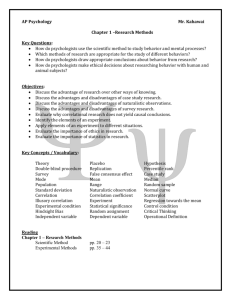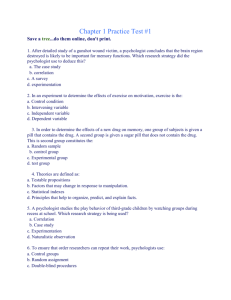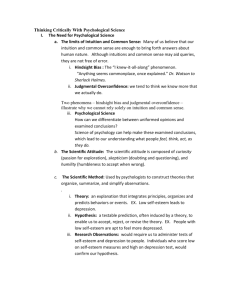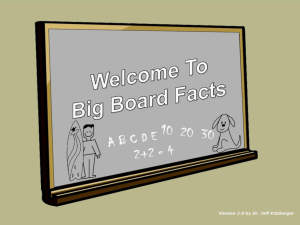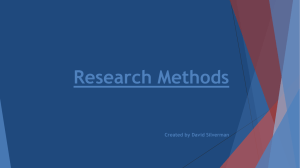Chapter 2 Research Methods in Industrial/Organizational Psychology
advertisement
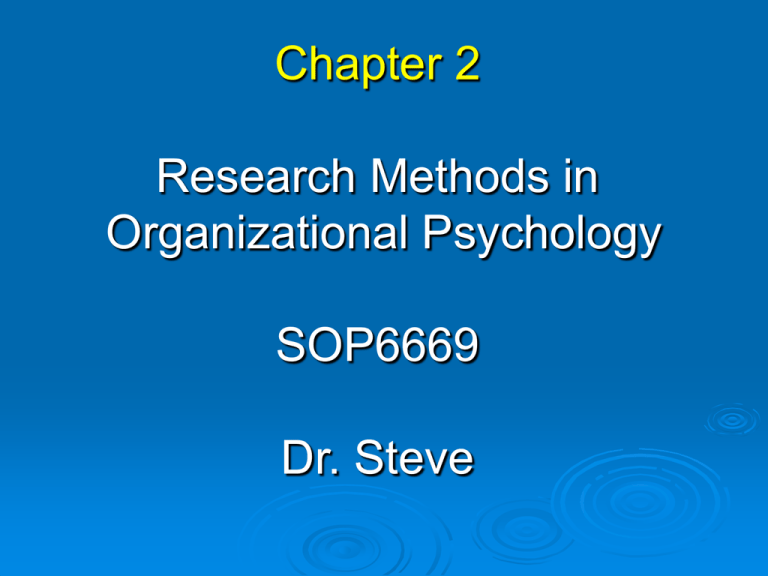
Chapter 2 Research Methods in Organizational Psychology SOP6669 Dr. Steve Research Methods Methods: Experiment / Quasi-Experiment Questionnaire/Survey Naturalistic Observation Case Study Meta-Analysis Research Methods Experiment Study conducted in a contrived environment Benefits: Provides more safety Cause and effect relationships • Manipulate I.V. (e.g., leadership style) • Measure D.V. (e.g., task performance) • Control extraneous variables (e.g., experience) Disadvantages: Time consuming Quasi-Experiment – not randomized or unable to manipulate IV (e.g., gender) Research Methods Questionnaire/Survey Self-report to obtain data on attitudes/behaviors conducted by phone, mail, interviews, electronically Benefits: Can collect a large quantity of data Disadvantages: Accuracy of reporting Representativeness of sample Return rate Research Methods Naturalistic Observation Observe overt behaviors over time Benefits: Systematic sampling at various times Representative sample Use to generate hypotheses Disadvantages: Experimenter bias Obtrusiveness Frequency of behavior occurring Research Methods Case Study In depth view of past events using interviews and archival records Benefits: Detailed account of why particular event occurred Disadvantages: Little generalizability Data Analysis Meta-analysis Meta-analysis – statistical procedure that combines the results of many independent research findings on a single topic Used to estimate true relationship Measures effect size of findings Uses archival data Research Steps Statistical Analysis Descriptive vs. Inferential Statistics Descriptive stats merely describe data Frequency Central tendency Variability Inferential stats used to test hypotheses T-Test Analysis of variance Correlation Regression Non-parametrics Data Analysis Central Tendency example scores = 5, 6, 6, 8, 9, 10, 11, 17 _ 1. Mean – average: X = ∑X / N Mean = 72 / 8 = 9 2. Median – middle score (when placed in order) - use when outliers exaggerate the mean Median = 8.5 3. Mode – most often occurring score Mode = 6 * In a normal distribution, Mean = Median = Mode Data Analysis Variability Range - distance between highest and lowest score (Range = High score – Low score) Range = 17 – 5 = 12 Standard Deviation – average distance from the mean S= Σ(x – x)2 / n – 1 S = (5-9) 2 + (6-9) 2 + (6-9) 2 + (8-9) 2 + (9-9) 2 + (10-9) 2 + (11-9) 2 + (17-9) 2 / 7 S = 3.85 Normal or Bell-shaped Distribution Frequency Data Analysis Skewed Frequency Distributions 20 18 16 14 12 10 8 6 4 2 0 65- 75- 85- 95- 105- 115- 125- 135- 145- 15574 84 94 104 114 124 134 144 154 164 IQ Scores Negatively Skewed Distribution 30 20 18 16 14 12 10 8 6 4 2 0 25 Frequency Frequency Positively Skewed Distribution 20 15 10 5 65- 67- 69- 71- 73- 75- 77- 79- 81- 82- 8466 68 70 72 74 76 78 80 82 83 85 Professional Golf Scores 0 250- 260- 270- 280- 290- 300- 310- 320- 330- 340259 269 279 289 299 309 319 329 339 349 Weight (lbs) of NFL Lineman Data Analysis Correlation r A B A 1.0 B .40 1.0 C .20 .09 Correlation ( r ) – Degree of relationship between two variables Used for prediction Cannot be used to infer causation Range from –1 to +1 Negative r – as one variable increases the other decreases Positive r – as one variable increases so does the other Zero r – no relationship between the two variables C 1.0 Data Analysis Correlation 600 College GPA 3.5 3 2.5 2 1.5 1 0.5 ** ** * ** **** ** * * *** * ****** * * * * * ** *** * * ** * ***** *** ** * * * * * *** * * * ** * *** * * * * * * * * * ***** *** * * * * * * * * * * ** ** *** * *** * * * * * *** * ** * * * * ** * * * ***** ** * * * * * ** * ** * ** 60 0 80 100 120 20 * Years of Practice 4 800 1000 1200 1400 1600 15 10 5 0 GRE Scores Positive Correlation Golf Scores Negative Correlation Correlation Examples IQ scores of identical twins: r = +.86 Phases of the moon & # acts of violence: r = .00 Economic conditions & # lynchings: r = -.43 Amount of ice cream sold & # drownings: r = +.60 Price of rum in Cuba & priests salaries in New England: r = +.38 Number of cigarettes smoked per day & incidence of lung cancer: r = ??? Statistical Methods Regression Regression Variables (used for prediction) Yi = ß0 + ß1Xi1 + ß2Xi2 (Y = a + b1X1) Predictor Variable (X) – measure used to predict an outcome (similar to independent variable) Criterion Variable (Y) – outcome to be predicted Example: selection test scores, years of experience, education level Example: work performance, turnover, sales, absenteeism, promotion, etc. Example: AFOQT scores as predictors of pilot training performance Statistical Pitfalls: Bias Representative Sampling Selecting a sample that parallels the population Might use covariates to account for differences Statistical Assumptions ANOVA assumes a normal distribution and independence • Lack of normality is only minor problem, but may want to identify distribution shape and why • Observations may not be independent, may need to aggregate (e.g., class instead of student) Statistical Pitfalls: Errors in Methodology Statistical Power – probability of detecting a true difference of a particular size Type I error – falsely reject null hypothesis when a true difference does not exist Type II error – fail to reject null hypothesis when a true difference does exist Power affected by • • • • Sample size Effect size (e.g., Cohen’s D) Type I error rate selected (alpha) Variability of sample (F ratio = var between group / var within group) Statistical Pitfalls: Errors in Methodology Multiple Comparisons – if you compare enough variables, will find a relationship by chance alone Bonferroni correction – family-wise adjustment (alpha = .05 / #comparisons) Replicate Cross-validate (holdout sample) Measurement Errors Reliability: Consistency of Measure Validity: Measures what it was designed to measure Statistical Pitfalls: Problems with Interpretation Confusion P value does not reflect effect size – could have a small effect, but a lot of power Precision over significance vs. Accuracy More decimals not necessarily more accurate Causality Correlations are not causal, but ANOVA may not be either Statistical Pitfalls: Problems with Interpretation Graphs May not provide accurate portrayal of data 84 100 83.5 80 83 60 82.5 Score Score 40 82 20 81.5 0 81 Group A Group B Group A Group B Research Critical Thinking Always think critically about the research you read Who were the participants in the study? How strong of a relationship was found? Was it causal or correlational? Was it a field study or laboratory study? How was data collected and analyzed? Do you agree with the conclusions based on the analyses provided? Ethical Principles of Research Privacy: Confidentiality: Participants have the right to limit the amount of information they reveal about themselves. If they decide to withdraw from the experiment at any time, they have the right to do so Participants have the right to decide to whom they reveal confidential information. By ensuring confidentiality, researchers may be able to obtain more honest responses Protection from Deception: Deception can only be used if the value of the research must outweigh the harm imposed on participants and the phenomenon cannot be measured any other way

